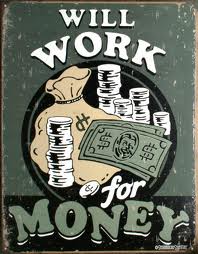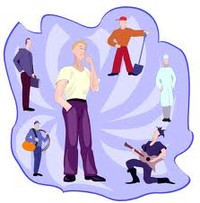Process
|
Part 1: Why Do We Need Money?
What item do you want to have more than anything? What could you do to get that item? Most of you have probably been able to obtain something you wanted by performing a service for someone, for pay. The service could have been mowing the lawn, cleaning the house, walking the dog. But what if the item you want more than any other can only be obtained at a store or by a person who has no need for your services? Will this person need your lawn-mowing service, or have a dog to walk, if he or she is located in a mall? Most likely not. So what is the solution to this problem? The Solution is money. Money is valuable to almost everybody because it is accepted as a medium of exchange almost everywhere. People can use it to get the things they want. |
|
Part 2: How Do People Receive Income?
How do people get money? There are many ways--by working for pay, receiving gifts, getting lucky at the lottery, and so on. But what is the most common way for people to get their money?
Print off this Pie Graph Handout. Once you have printed out the handout you will need to find an adult and a friend (your age) who are willing to be interviewed. Ask them what percent of the money they receive comes from working, gifts, winning the lottery, etc. Compile your data and construct pie graphs in the spaces provided on the handout. Do you see any pattern emerging?
How do people get money? There are many ways--by working for pay, receiving gifts, getting lucky at the lottery, and so on. But what is the most common way for people to get their money?
Print off this Pie Graph Handout. Once you have printed out the handout you will need to find an adult and a friend (your age) who are willing to be interviewed. Ask them what percent of the money they receive comes from working, gifts, winning the lottery, etc. Compile your data and construct pie graphs in the spaces provided on the handout. Do you see any pattern emerging?
Part 3: Choosing Your Enterprise
Enterprise is another word for a business. Having a business is one way to make money, develop skills, or helpothers. At the Bureau of Labor and Statistics (BLS) Career Information Web site you will find helpful information about different careers and what it takes to excel in them.
You might be a little young to get started in a career, but being young doesn't need to stop you from thinking about jobs you could do right now. Brainstorm a list of jobs you can do. Get together with classmates and combine your lists. From your list or a list of compiled from the responses of all your classmates, complete the Job List Worksheet.
Completing the worksheet should help you think about the job that might be best for you.
Enterprise is another word for a business. Having a business is one way to make money, develop skills, or helpothers. At the Bureau of Labor and Statistics (BLS) Career Information Web site you will find helpful information about different careers and what it takes to excel in them.
You might be a little young to get started in a career, but being young doesn't need to stop you from thinking about jobs you could do right now. Brainstorm a list of jobs you can do. Get together with classmates and combine your lists. From your list or a list of compiled from the responses of all your classmates, complete the Job List Worksheet.
Completing the worksheet should help you think about the job that might be best for you.


